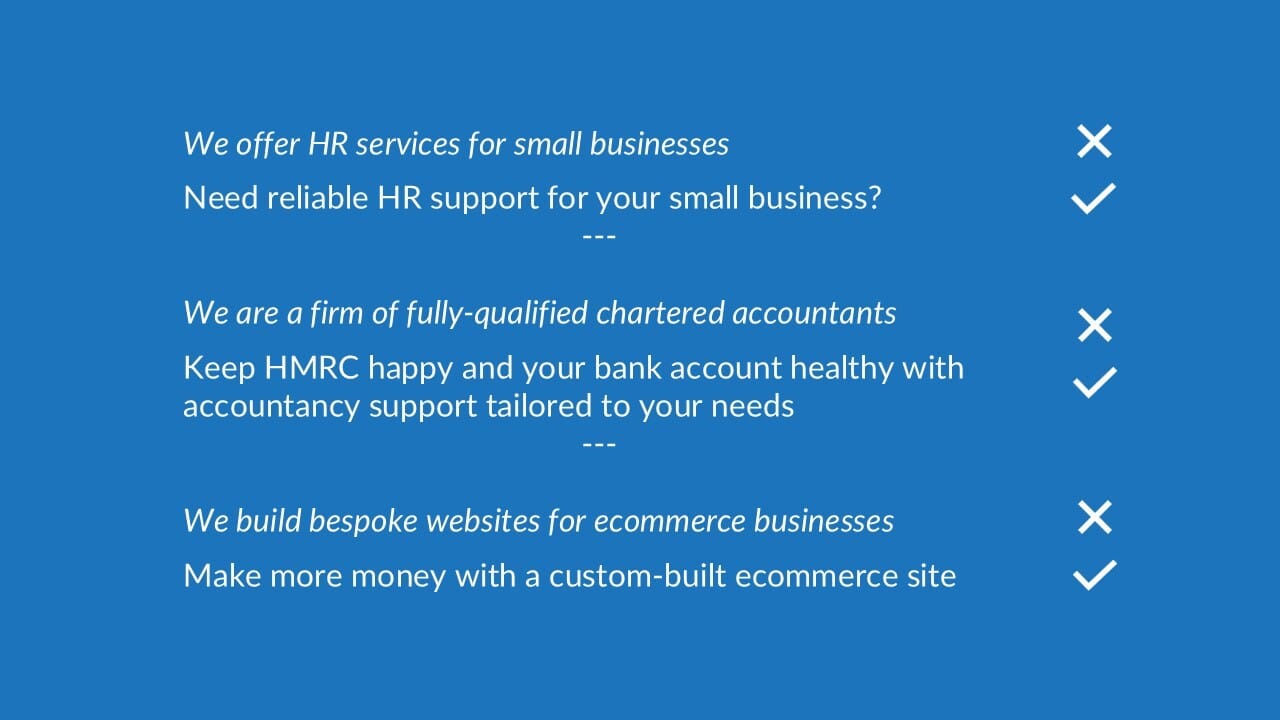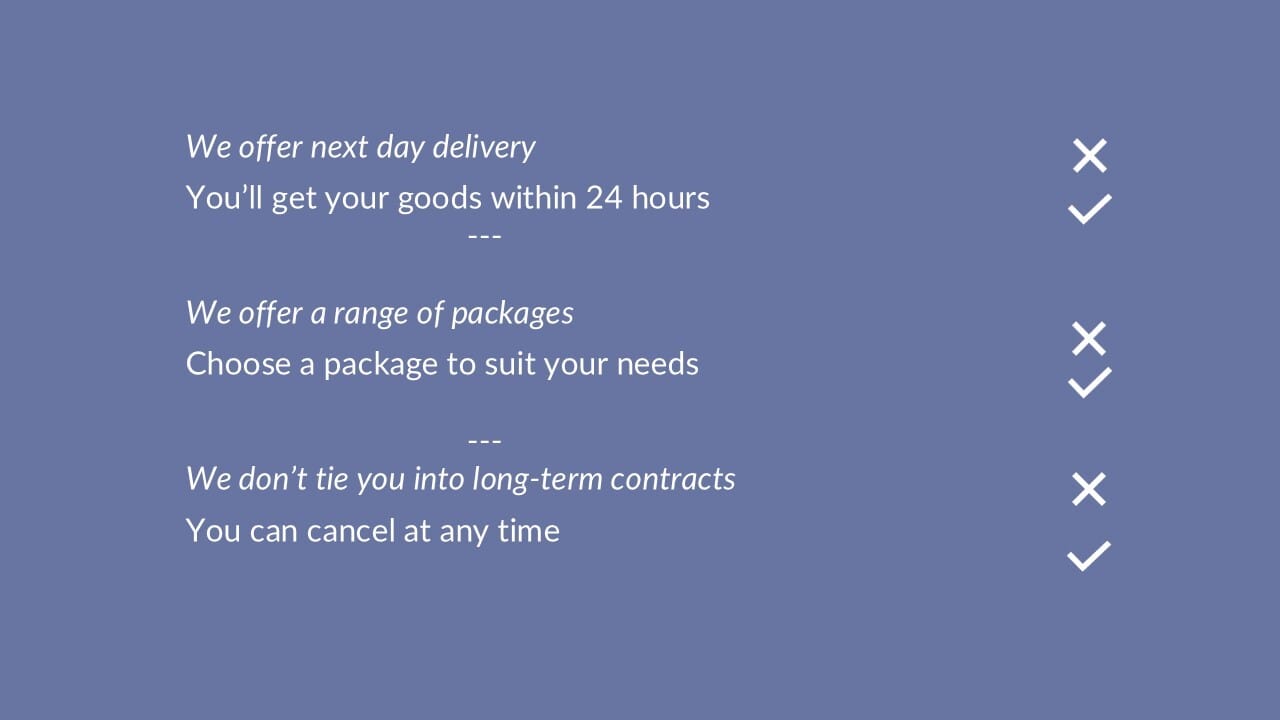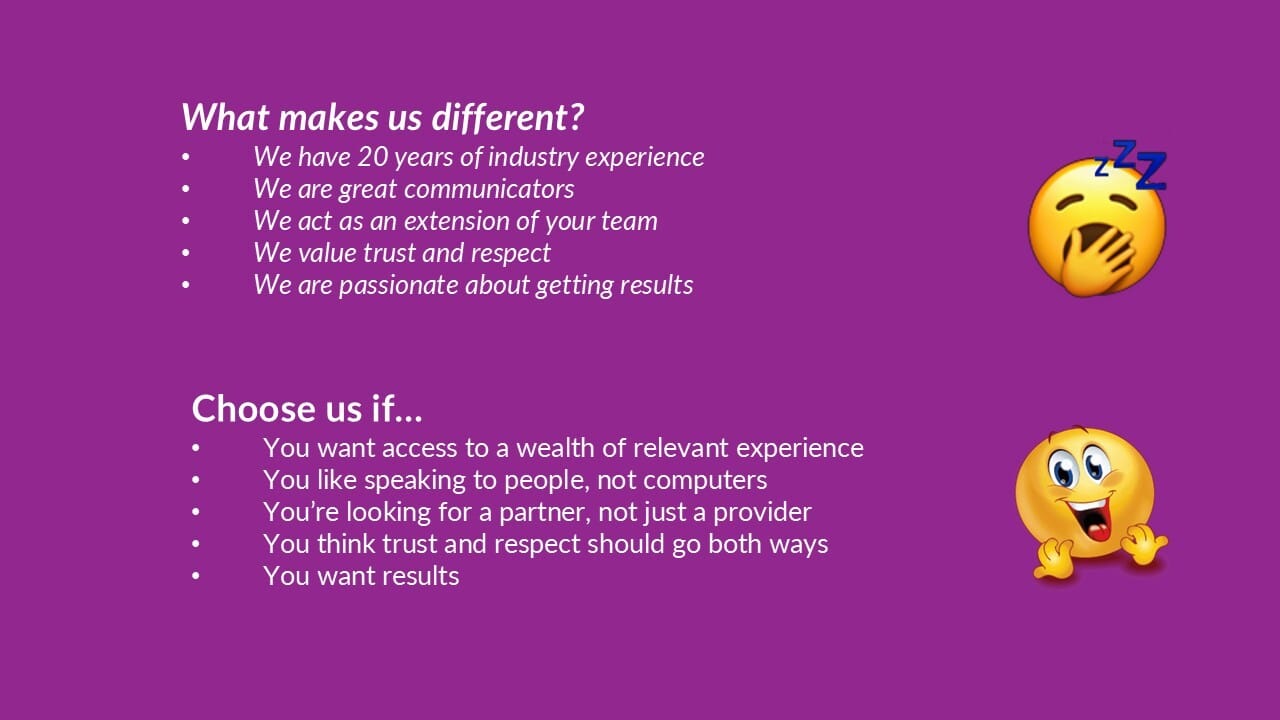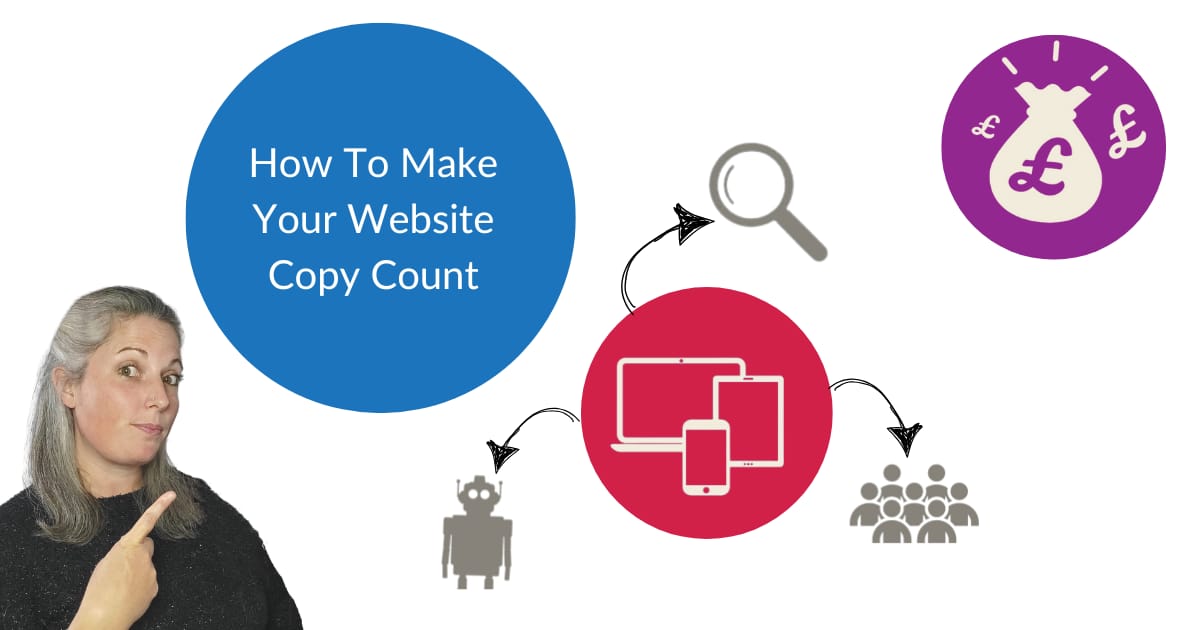5 Common copy mistakes
Let’s start by taking a look at some of the most common copy mistakes. If you’re guilty of doing any of these, there’s good news – they are easy to fix. A few tweaks and you can transform your website copy.
Mistake 1: Not optimising the opening line
When a potential customer lands on your home page, they want to know whether you offer what they need. They don’t want to search for the answer. They want you to tell them straight away.
So rather than welcoming people to your website, tell them what you do, who you help, or why they should hang around.
“Delicious cakes delivered to your door”
“Accountancy services for busy salon owners”
“Guaranteed ROI or your money back”
Mistake 2: Opening with an “About Us” section
It’s amazing how many people open their website by talking about themselves.
No mention of the problems they solve or outcomes they deliver. Nothing about the reader. Just straight in with an “About Us” section.
If you met someone at a party or networking event and all they did was talk about themselves for the first twenty minutes, you’d be looking for any excuse to ditch them.
Why would your website visitors be any different? They don’t want to know about you – they want to know what you can do for them.
So focus on your reader first. Let them know they are in the right place and give them a reason to stick around.
Opening with a question or a couple of questions can be a great way of ‘starting a conversation’. Identify a problem they might be having or a need they might have.
“Is your website copy letting you down?”
“Are you tired of attracting the wrong type of enquiry?”
By asking questions, you’re helping your readers figure out whether they are in the right place. And if they are, they’ll keep on reading.
Mistake 3: ‘We-ing’ on people
Some people have a weird tendency to talk extensively about themselves on their website:
“We have over ten years of industry experience and we are passionate about what we do. We offer a wide range of services, and we can tailor our support to suit the needs of any business. We are friendly, reliable and professional. We pride ourselves on delivering excellent service.”
We. We. We.
I refer to this as we-ing on people, and it’s boring. As I said above, readers don’t want to know about you – they want to know how you can help them.
And in case you were wondering, this totally applies to the use of the word “I” just as much: “I am a qualified X. I have over ten years of industry experience. I am passionate…”
Stop talking about yourself and start talking about the reader instead.



Mistake 4: Burying important information
Your website visitors are busy people, and they don’t want to waste time searching for information. Make it easy for them to navigate your website and find what they are looking for.
Think about each page – what needs to be on there? What questions would readers have about your products or services? What concerns would they have about buying?
Ensure the most important information stands out – don’t hide it. Make your pages scannable by including subheadings or clearly labelled text boxes, so readers can find what they’re looking for quickly.
Include frequently asked questions and testimonials on the relevant pages so readers don’t have to hunt your site for them.
Mistake 5. Not including a call to action
If your reader reaches the end of a page and there is no call to action, you’re putting the responsibility on them to make a decision. Should they call you? Email you? Hunt your website for a contact form? Search for your Facebook page?
People like getting clear instructions as it makes life easier – they don’t have to figure it out themselves and are less likely to make the wrong choice.
So tell people what to do next.
Make your call to action assertive. Put a verb at the beginning – an action word.
Instead of “If you like our content, subscribe to our newsletter”, try, “Subscribe to our newsletter for more great content.”
Instead of “Our new brochure is available to download here,” try, “Download our new brochure here.”
And make it as easy as possible for people to take that action. If you want them to follow a link, include a clickable link or button. If you want them to call you, make sure your number is visible. If you want them to give you money, add a payment portal.
The easier it is to take action, the more likely readers are to take it.
5 easy ways to update your website
The good news is you can quickly freshen up your copy without having to give it a complete overhaul. Here are 5 easy ways to update your website copy…
1. Update testimonials & case studies
When you first built your website, you probably added all your best testimonials and case studies, but how many other projects have you completed since then?
Ask clients that you’ve worked with recently to provide a testimonial. Write up the details of your latest projects and use the case studies to showcase your services. Remove any testimonials or case studies that are no longer relevant, for example, those that mention any services that you no longer provide.
Keeping your testimonials and case studies up to date shows potential clients that your work now is still as good as it’s always been (if not better).
2. Check the relevance of date references, accreditations and awards
Skim through your copy looking for phrases such as “last year we…”, “in the last 12 months we…” or “we started our company X years ago”. These types of phrases quickly go out of date.
Pay particular attention to any awards or accreditations that you have mentioned. Is it really going to impress a potential client if you are still talking about an award you were nominated for five years ago (especially if you’ve won even more since then)?
If you are showing accreditation or certification logos on your site, check you’re using the most up-to-date logos (and you are still accredited). You don’t want to get caught out listing a certification that you no longer have, or claiming to be a member of an association that no longer exists.
3. Update your services and pricing
Check your services pages. Maybe you’ve started offering new services, or perhaps you’ve recently stopped offering a service that wasn’t very popular or profitable.
If you have packages, make sure these are listed correctly, and if you’re advertising your prices, ensure you have the most up-to-date prices on your site. If you are still promoting last year’s rates on your site, you could be misleading your customers.
4. Check any links and forms work properly
It’s a tedious job, but going through your content and ensuring all the links still work is important. Not only does it prevent readers from getting frustrated by broken links, but it can also damage your SEO if you are linking to any dodgy or expired websites.
Go through all your pages and blog posts, and make sure both the internal and external links work as they should.
Test out any enquiry or contact forms to ensure that messages are getting through to the right email address. Otherwise, you might be missing out on new enquiries.
5. Update your blog
I’ve lost count of the number of websites that haven’t updated their blog since their site went live. It’s disappointing to click on a blog and find a single post promising loads of interesting content, top tips and updates that have never materialised.
If your blog has not been updated in the last 12 months, visitors might wonder if you are even still in business. So if you have an unused blog on your website, either remove it or start adding content to it.
Does your website need a blog?
There’s no point sending loads of people to your website if the copy is dull and uninspiring. And an engaging blog, packed with advice, tips and useful information will help you attract more readers.
Benefits of having a blog:
Build brand awareness
Increase social media engagement
Improve search engine optimisation (SEO)
Build relationships with potential and existing clients
Establish yourself as an expert
Drive more traffic to your website
Generate leads
You don’t have to suddenly start posting every day – a quality blog post once a month or an in-depth article once a quarter is more than enough to get started.
If you’d like to receive my weekly email updates and monthly results, hit subscribe, and I’ll be in your inbox every Friday.
P.S. I also have a free 14-day email course to help you improve your sales copy and marketing content. You can find out more and sign up here.


